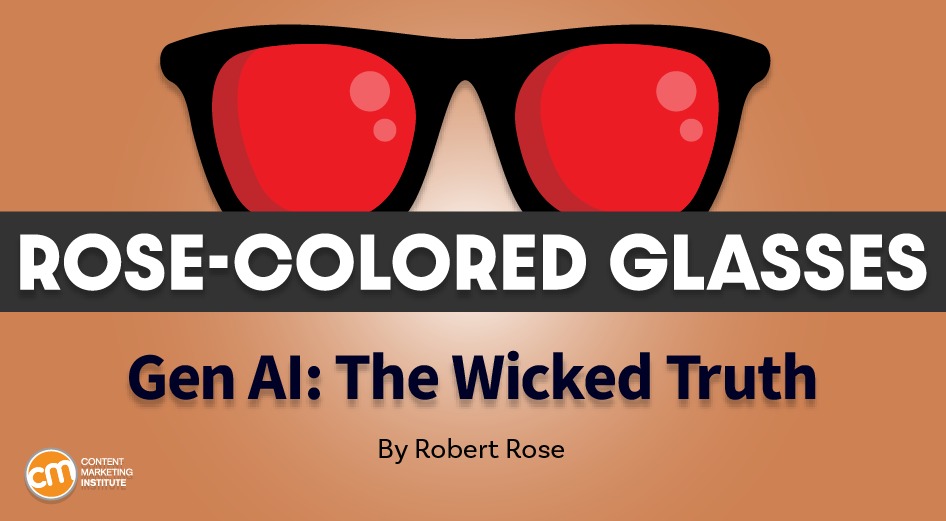Over the past few months, I’ve been bombarded with messages from major AI solution providers. Unfortunately, those messages have created a rush to deploy general AI across marketing and Creative efforts.
We are going the wrong way with creative AI.
For example, Recent quote from OpenAI CTO Mira Murati When asked about AI replacing humans, he said: “Some creative jobs may go away, but maybe they shouldn’t have been there in the first place.”
Actually?
But she’s not the only one making statements along these lines. Open AI CEO Sam Altman declared that AI will handle “95% of what marketers, agencies, strategists, and creative professionals use today.”
And of course, there is This famous quote by economist Richard Baldwin at the World Economic Forum Development Summit 2023: “AI will not take your job. Someone using AI will take your job.”
Now, neither of these statements are entirely true or false. If you take any of these statements apart, you’ll hear some people say, “Well, what they mean is….”
And that’s the problem. It’s not the accuracy of the statement – it’s the interpretation.
Tech companies are making technology the hero of the story. They’re telling people to feel lucky to deserve such amazing tools. And they’re making the argument that human creativity is a problem that needs to be solved.
It’s ironic when you consider how all of these technologies use human creativity to develop.
That path lies in complex mediocrity.
In this AI gold rush, business leaders are rushing to tell investors, analysts, customers, and audiences that How many roles can they replace with technology? in the name of efficiency.
But do some early adopters regret these decisions? Two researchers think so. They published an article in Harvard Business Review last year arguing that while the initial numbers may “look good, especially in terms of cost cutting, the company will miss out on the opportunity to achieve big profits by creating significant value—or a defensible niche in the future.”
I see this happening in some companies that have replaced human content creators with creative AI. Yes, they are producing more content than ever before — they have succeeded in creating efficiency in content production at scale.
And the content they create? It’s average. It’s not bad enough or good enough to be noteworthy. It’s just average.
And it is leading us into an age of complex mediocrity.
The Bad Things in Content and Marketing
I have written about the “ dilemma ” in the marketing and content strategies of businesses a few years ago.
One bad problem Wicked problems are difficult to solve because “requirements are incomplete, contradictory, or change so dramatically that they are difficult to recognize.” Information scientist Jeff Conklin describes wicked problems as those that “cannot be understood until a solution is proposed.”
Think about how you organize your kitchen. It may work well enough for you, so you don’t see how much better it could be until someone suggests changes that would make it work much better. Only then do you realize you actually have a problem worth solving.
Wicked problems are rampant in marketing. Your content or marketing approach may be working fine. You know it’s not firing on all cylinders, but nothing is so dysfunctional that fixing it becomes a top priority.
But then you try to fix some minor issues and realize that many other areas of performance need improvement as well. Are the issues serious enough to cause disruption? Unfortunately, you won’t know until you try.
For example, about three months ago, I worked with a rapidly growing tech company to implement a new governance model, workflows, and content lifecycle plan. People who had been with the company for less than a year were thrilled. They loved it.
But senior leaders and some veteran marketing and content experts disagree. They agree that the new plan looks good. But they don’t consider the problem it solves important enough to spend time solving.
That is evil.
I often hear CEOs and CFOs ask, “What’s the benefit of fixing this problem?” The answer is, “We don’t know yet.”
Why AI Generation Isn’t Such a Bad Problem (Maybe)

Unfortunately, the exaggerated claims about AI genes replacing humans or teams have created what seems like a bad problem in the fields of creativity and marketing.
Business leaders hear about the rise of AI and think, “This is a great innovation. We must have a problem that can be solved – we just don’t know what it is.”
Then, with hyped promises of AI replacing agencies and creatives, the view shifted to “Some of our creative work may be redundant and obsolete. Maybe that’s a problem AI can solve for us.”
I’m not saying that there aren’t some organizations that hire more people than they need or could improve efficiency or productivity. And those are bad problems.
But deploying AI genes as a (theoretically) cost-effective alternative to humans interacting with customers or creating content is often not the way to solve a serious problem.
That is solutionism.
Against the message of solutionism
Solutionism, a term Popularized by tech critics Evgeny Morozov, describes the belief that every problem can be solved with a technological solution.
And solutionism is at the heart of all these claims being made by general AI solution providers.
When Mira Murati says that some creative roles “should never have existed in the first place,” she is fostering the notion that the need for creative roles is a problem that can be solved with technology.
When Sam Altman says “95% of what marketers use agencies, strategists, and creatives for today” will be handled by AI, he suggests that inefficiencies in the art of creative marketing need to be fixed.
And the warning sticker “AI won’t take your job, but someone using AI will” suggests that creative AI is the hero we should prove worthy of.
Believing these claims pushes us into an era of complex mediocrity. It means we accept trading diversity of human thought for a complex solution to a non-existent problem.
No CEO wakes up and says, “We have too many people with too many creative ideas. Let’s save some money and get rid of them.” But when CEOs ask their teams to figure out how many (or what resources) they can eliminate by AI gene deployment then they are forced to calculate that.
There are things we can do to avoid this trap. The most important thing is to take a very important first step: Understand and make a note of the opportunity you plan to apply AI to. That sounds obvious. but I see more and more companies failing to do that with creative AI.
Just last week, have information for that 20,000 employees of energy giant Chevron are testing Microsoft Copilot a suite of AI-powered chatbots and other tools within Microsoft’s Office 365 apps that can answer questions and draft emails. The problem? “We were a little bit unsatisfied with our ability to know how well it was working,” according to Bill Braun, the company’s CIO.
My point is they will continue to do so. You can’t give 20,000 people a solution to a non-existent problem and expect them to report back accurate value.
For any effective enterprise-wide innovation implementation, you must first understand what value you want to measure. And to do that, you must understand the current process that is worth measuring. Chevron can’t truly achieve overall value until it understands what it is trying to solve.
I’m not against creative uses of AI. I’m cautioning against using specific arguments to promote the technology. There are plenty of bad problems to be solved in content and marketing. And many of the activities we do every day could be improved by technology like synthetic AI.
It is important to understand the difference between solving a real problem and applying technological solutions to problems that do not exist.
And that’s how you avoid complex mediocrity.
Source contentmarketinginstitute.com
Comment Policy: We truly value your comments and appreciate the time you take to share your thoughts and feedback with us.
Note: Comments that are identified as spam or purely promotional will be removed.
To enhance your commenting experience, consider creating a Gravatar account. By adding an avatar and using the same e-mail here, your comments will feature a unique and recognizable avatar, making it easier for other members to identify you.
Please use a valid e-mail address so you can receive notifications when your comments receive replies.
